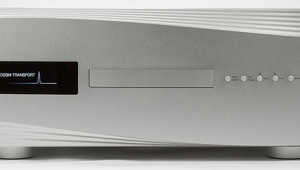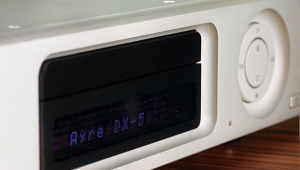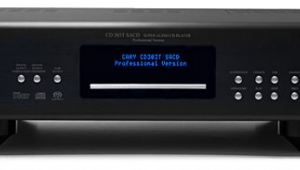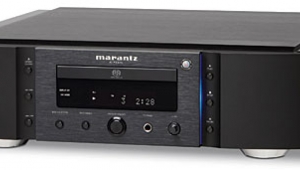| Columns Retired Columns & Blogs |
Cary Audio Design CD 306 SACD Professional Version SACD/CD player
Some reviews take longer to gestate than others. But in the case of Cary's CD 306 SACD Professional Version SACD/CD player, it has taken me literally years to get this review into print. I had visited Cary's impressive facility in North Carolina just before Christmas 2005, when I'd been playing the high-resolution master files of some of my recordings at an event being promoted by Raleigh high-end dealer Audio Advice. Cary's head honcho, Dennis Had, had been playing me music on a system featuring his Silver Oak loudspeakers, with the front-end one of the first samples of the original CD 306, playing discs through the two-chassis Cary SLP 05 preamplifier that Art Dudley ended up reviewing in the September 2006 issue. "Now that's a product I'd like to review!" I enthused, looking inside the CD 306, and I drove back to Brooklyn with a review sample.
Footnote 1: The Ayre KX-R preamplifier, reviewed by Wes Phillips elsewhere in this issue, also excels at this aspect of reproduction. I enthusiastically endorse WP's recommendation.—John Atkinson

However, I had to cut short my auditioning of the first review sample (S/N 0530630184): the player would stop playing after a couple of hours' operation, and wouldn't work again until it had been turned off for a while. I let Had know what was wrong—obviously, this sample was not ready for prime time. It transpired that one of the Sony chips in the transport-servo circuitry didn't always meet its temperature-tolerance specification. Once the player had warmed up, the out-of-tolerance chip would stop working reliably.
Had asked me to return this sample to have the problem chip replaced and also to have its firmware upgraded to address some operational problems that had emerged in the field. Cary shipped me a new sample (S/N 053063030280) in April 2006. This sample worked fine, without turning off. However, it also had a minor problem in that it didn't handle hi-rez data correctly through its digital input. I was wondering whether to return this sample to Cary when I received an e-mail from Dennis: "I am writing to let you know we are in a complete redesign of the CD 306/SACD....The [Pacific Microsonics PMD200] filter chip is no longer available. Therefore we are in a complete re-design mode."
As the first production run of CD 306s had all been sold by this time, there seemed little point in continuing with the review. Dennis agreed to send me a review sample of the redesigned player when it was available, and I would review that instead. The review sample of what was now the CD 306 SACD Professional Version (S/N 08306PV6018) arrived in spring 2008, but such was the backed-up state of my personal review queue that I couldn't begin this one until a couple of months ago.
The Professional Version
Like its predecessor, the CD 306 SACD Professional Version SACD/CD player ($8000) is a handsome front-loading model finished in polished aluminum or black and supported on four conical feet (these can be rotated to level the player). Whereas the earlier version had a circular window in the top panel above the transport section, the Pro has six curved rectangular vents, shielded with wire mesh. Otherwise it looks identical, with a blue 20-character alphanumeric display in the front panel's central black section, above the thin-profile disc tray. One row of pushbuttons on the right of the front panel controls the transport functions (other than Pause, which is found only on the remote), another the choice of SACD or CD, multichannel or two-channel SACD data, and internal disc or external data input. A single row of buttons on the left of the front panel selects the sample rate for the digital output when playing CDs (44.1, 96, or 192kHz), the internal sample-rate converter frequency for CD playback (44.1, 96, 192, 384, 512, or 768kHz), and Text Display mode for SACD playback. All functions are also available on the remote control, and the upsampling rate can be changed on the fly, with only a brief silence between settings.
The rear panel carries sets of balanced and unbalanced Left and Right analog output jacks—there are no multichannel analog outputs—with the balanced XLRs wired with pin 2 hot. There are also three digital output jacks (AES/EBU via XLR and S/PDIF via coaxial and TosLink jacks), which are operational for CD playback only, and three digital inputs (again, AES/EBU via XLR, and S/PDIF via coaxial and TosLink jacks). Finally, an RS-232 port allows the player's firmware to be updated.
Inside, copper-plated partitions run from front to back, dividing the chassis into three sections. The transport—sourced, I believe, from Sony—occupies the central section, with a circuit board behind it carrying the control circuitry and the digital input/output circuitry. To the transport's left is a massive power supply, with heatsunk voltage regulators and multiple electrolytic reservoir capacitors. To the right is a full-depth, multilayer printed circuit board that carries, on its front section, even more power-supply circuitry, and, at the rear, the D/A and analog stages.

For SACD playback, the system's master clock runs at 22.5792MHz (512Fs) rather than the usual 11.2896MHz. The two-channel DSD data recovered from SACD are fed to four Burr-Brown PCM-1792u two-channel D/A chips, four used in parallel for each channel to give dual-differential balanced operation.
For CD playback, the PCM data are fed to a Burr Brown DF-1706 oversampling digital filter, which also offers HDCD decoding via external software. The 24-bit/192kHz-sampled output of this filter is again fed to the array of Burr-Brown PCM-1792u chips, now operating in PCM mode. The DAC outputs are fed to the solid-state output stage, which appears to be based on high-quality op-amp chips. (This may be a Cary, but there are no tubes to be seen under this baby's hood. That is, if I could get under the hood—the chassis's apparently boltless construction gives no clue as to how to get inside; my observations are based on looking at Cary's own photo of the interior.) The analog output's low-pass filter is specified as being a well-behaved, third-order Bessel type.
Given that the oversampling ratio can be increased from just over 4x (to 192kHz) to more than 16x (768kHz), but that the DACs themselves are specified as running up to only 200kHz, I wonder if the higher oversampling ratios are achieved by time-sharing the high-rate data among the DACs, the tradeoff being a slight loss of resolution compared to when the DACS are used in parallel at the lower sample rates. (This mode of operation was first seen in the Cambridge Audio CD1 of 1986, where four TDA1541 chips were used to handle data oversampled at 16x the base frequency.) On the other hand, the DF-1706 chip can output filtered data only at a maximum sample rate of 192kHz, so I'm really no closer to grasping the CD 306's architecture than I was when I began writing this paragraph.
I experienced two operational niggles with the CD 306, neither very important: 1) When I placed an SACD in the open tray and pressed Play, the drawer closed and the disc was loaded, but wouldn't actually play until I pressed Play a second time. 2) With some discs, the player defaulted to the multichannel data, meaning that no music was audible. Pressing the Mch/2Ch button restored the sound, but I had understood from the manual that the default priority with fully-loaded SACDs was given to the two-channel data. Otherwise, the CD 306 worked flawlessly all the time I had it in my system, and SACDs were always quick to load and play.
Sound—SACD
In a word, smooth. Not smooth as in rolled-off or mellow or dull, but with SACD playback, smooth in the sense of the high frequencies having a natural silkiness, without a trace of unnatural sheen or metallic nature. The violins in Tchaikovsky's Serenade for Strings, with Daniel Gatti conducting the Royal Philharmonic (SACD, Harmonia Mundi USA HMU807394), sounded about as close to the real thing as I have experienced from recorded sound.
In recent Stereophile reviews, Michael Fremer has been talking about "continuousness," Bob Reina about something sounding "organic." Having spent time with both writers, listening with them to their systems, I believe they are talking about the same phenomenon: that quality in which no single aspect of the sound calls attention itself, but there is instead a seamless presentation in which the acoustic objects representing instruments and voices are naturally embedded within the whole while retaining their individuality, just as happens in real life. The whole is more than the sum of its parts; the music flows unimpeded by artifice (footnote 1).
Footnote 1: The Ayre KX-R preamplifier, reviewed by Wes Phillips elsewhere in this issue, also excels at this aspect of reproduction. I enthusiastically endorse WP's recommendation.—John Atkinson
- Log in or register to post comments




































